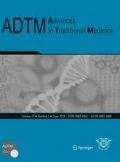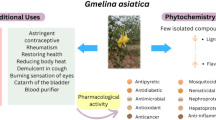Abstract
Ethanolic extracts of leaves and hypocotyls of a mangrove plant, Bruguiera gymnorrhiza (Family Rhizophoraceae), were investigated to identify the presence of different phytochemicals and to assess the antihyperglycemic, antidiarrheal, analgesic and antioxidative activity in the current study. Oral glucose tolerance test (OGTT) was performed to investigate the in vivo antihyperglycemic activity and leaves extract (LE) was found to possess significant antihyperglycemic property compared to hypocotyl extract (HE). Therefore, the leaves extract was considered for α-Glucosidase enzyme inhibitory activity test and substantial α-glucosidase enzyme inhibitory property was observed with an IC50 (concentration required to inhibit 50% enzyme) value of 2.670. Antioxidative activity of plant extracts was tested in vitro by evaluating their ability to scavenge DPPH, hydrogen peroxide and hydroxyl radical as well as superoxide anions. In all cases, LE showed greater activity than HE. In addition, LE demonstrated higher amount of total phenolics, flavonoids and tannins indicating higher antioxidant effect compared to HE. For the evaluation of antidiarrheal effect in castor oil induced diarrheal mice, both extracts showed significant inhibition of defecation at doses 250 and 500 mg/kg body weight. Finally, for acetic acid-induced writhing method to evaluate the analgesic activity, significant percentage inhibition of writhing (P < 0.05 vs. control) was observed for both extracts at lower and higher doses. Altogether, these studies justified the plant’s usage in folklore medication.



Similar content being viewed by others
References
Allen JA, Duke NC (2006) (large-leafed mangrove). In: Elevitch CR (ed) Species profiles for Pacific Island agroforestry. Permanent Agriculture resources (PAR), Holualoa, Hawai'i
American Diabetes Association (2014) Diagnosis and classification of diabetes mellitus. Diabetes Care 37:S81–S90
Ayoola G, Coker H, Adesegun S, Adepoju-Bello A, Obaweya K, Ezennia E, Atangbayila T (2008) Phytochemical screening and antioxidant activities of some selected medicinal plants used for malaria therapy in Southwestern Nigeria. Trop J Pharm Res 7(3):1019–1024
Biswas B, Golder M, Islam T, Sadhu SK (2018) Comparative antioxidative and antihyperglycemic profiles of pneumatophores of two mangrove species Avicennia alba and Sonneratia apetala. Dhaka Univ J Pharm Sci 17(2):205–211
Bnouham M, Merhfour F-Z, Ziyyat A, Mekhfi H, Aziz M, Legssyer A (2003) Antihyperglycemic activity of the aqueous extract of Urtica dioica. Fitoterapia 74(7–8):677–681
Burkill IH (1966) A dictionary of the economic products of the Malay Peninsula. Ministry of Agriculture and Co-operatives, Kuala Lumpur
Chaturvedi P, Chowdhary A (2014) Hypoglycemic activity of Murraya koenigii (Meethaneem) leaves collected from Udaipur, Rajasthan (India). Am J Ethnomed 1(6):409–417
Das SK, Samantaray D, Patra JK, Samanta L, Thatoi H (2016) Antidiabetic potential of mangrove plants: a review. Front Life Sci 9(1):75–88
Grover J, Yadav S, Vats V (2002) Medicinal plants of India with anti-diabetic potential. J Ethnopharmacol 81(1):81–100
Ibrahim O, Shwaysh M (2016) Evaluation of Punica granatum peels extracts and its phenolic, alkaloid and terpenoid constituents against chemically induced diarrhoea in rats. Adv Anim Vet Sci 4(3):161–168
Imam MZ, Moniruzzaman M (2014) Antinociceptive effect of ethanol extract of leaves of Lannea coromandelica. J Ethnopharmacol 154(1):109–115
Jansen P, Cardon D (2005) Dyes and tannins. In: Plant resources of tropical Africa, Programme PROTA, 3rd vol. Netherlands
Joy K, Kuttan R (1999) Anti-diabetic activity of Picrorrhiza kurroa extract. J Ethnopharmacol 67(2):143–148
Jung J, Park M, Lee M, Kang HC, Kang Y-H, Kim ES SK (2006) Antidiabetic agents from medicinal plants. Curr Med Chem 13(10):1203–1218
Keser S, Celik S, Turkoglu S, Yilmaz O, Turkoglu I (2012) ydrogen peroxide radical scavenging and total antioxidant activity of hawthorn. Chem J 2(1):9–12
Koster R, Anderson M, De Beer EJ (1959) Acetic acid for analgesic screening. Fed Proc 18:412–417
Kunchandy E, Rao M (1990) Oxygen radical scavenging activity of curcumin. Int J Pharm 58(3):237–240
Kwon YI, Apostolidis E, Shetty K (2007) Evaluation of pepper (Capsicum annuum) for management of diabetes and hypertension. J Food Biochem 31(3):370–385
Lawag IL, Aguinaldo AM, Naheed S, Mosihuzzaman M (2012) α α-Glucosidase inhibitory activity of selected Philippine plants. J Ethnopharmacol 144(1):217–219
Mahmud I, Zilani MNH, Biswas NN, Bokshi B (2017) Bioactivities of Bruguiera gymnorrhiza and profiling of its bioactive polyphenols by HPLC-DAD. Clin Phytosci 3(1):11
Marinova D, Ribarova F, Atanassova M (2005) Total phenolics and total flavonoids in Bulgarian fruits and vegetables. J Chem Technol Metall 40(3):255–260
Matsui T, Tanaka T, Tamura S, Toshima A, Tamaya K, Miyata Y, Tanaka K, Matsumoto K (2007) α-Glucosidase inhibitory profile of catechins and theaflavins. J Agric Food Chem 55(1):99–105
Momin R, Kadam V (2011) Determination of ash values of some medicinal plants of genus Sesbania of Marathwada region in Maharashtra. J Phytol 3(12):52–54
Moree SS, Kavishankar G, Rajesha J (2013) Antidiabetic effect of secoisolariciresinol diglucoside in streptozotocin-induced diabetic rats. Phytomedicine 20(3–4):237–245
Nebula M, Harisankar H, Chandramohanakumar N (2013) Metabolites and bioactivities of Rhizophoraceae mangroves. Nat Prod Bioprospect 3(5):207–232
Patel D, Kumar R, Laloo D, Hemalatha S (2012) Diabetes mellitus: an overview on its pharmacological aspects and reported medicinal plants having antidiabetic activity. Asian Pac J Trop Biomed 2(5):411–420
Perry LM, Metzger J (1980) Medicinal plants of east and southeast Asia: attributed properties and uses. MIT press, Cambridge
Qaisar MN, Chaudhary BA, Sajid MU, Hussain N (2014) Evaluation of α-glucosidase inhibitory activity of dichloromethane and methanol extracts of Croton bonplandianum Baill. Trop J Pharm Res 13(11):1833–1836
Rahman M, Ahmed A, Shahid I (1963) Phytochemical and pharmacological properties of Bruguiera gymnorrhiza roots extract. Int J Pharm Res 3(3):63–67
Rahman M, Chowdhury M, Uddin A, Islam MT, Uddin ME, Sumi CD (2015) Evaluation of antidiarrheal activity of methanolic extract of Maranta arundinacea Linn. leaves. Adv Pharmacol Sci. https://doi.org/10.1155/2015/257057
Raj CN, Balasubramaniam A, Nadeem S (2013) Antidiarrheal potential of Tabernaemontana divaricata. Phytopharmacology 4(1):61–68
Sadhu SK, Okuyama E, Fujimoto H, Ishibashi M (2003) Separation of Leucas aspera, a medicinal plant of Bangladesh, guided by prostaglandin inhibitory and antioxidant activities. Chem Pharm Bull 51(5):595–598
Sarkar KK, Mitra T, Acharyya RN, Sadhu SK (2019) Phytochemical screening and evaluation of the pharmacological activities of ethanolic extract of Argemone mexicana Linn. aerial parts. Orien Pharm Exp Med 19(1):91–106
Soonthornchareonnon N, Wiwat C, Chuakul W (2012) Biological activities of medicinal plants from mangrove and beach forests. Mahidol Univ J Pharm Sci 39(1):9–18
Sur TK, Hazra A, Hazra AK, Bhattacharyya D (2016) Antioxidant and hepatoprotective properties of Indian Sunderban mangrove Bruguiera gymnorrhiza L. leave. J Basic Clin Pharm 7(3):75–79
Talukder C, Saha S, Adhikari S, Mondal HK, Islam MK, Anisuzzman M (2012) Evaluation of antioxidant, analgesic and antidiarrhoeal activity of Flacourtia jangomas. (Lour.) Raeusch leaves. Pharmacologyonline 3:20–28
Tambe VD, Bhambar R (2014) Estimation of total phenol, tannin, alkaloid and flavonoid in Hibiscus tiliaceus Linn. wood extracts. Res Rev J Pharmacogn Phytochem 2(4):41–47
Thatoi H, Patra J, Das S (2014) Free radical scavenging and antioxidant potential of mangrove plants: a review. Acta Physiol Plant 36(3):561–579
Uddin SJ, Grice ID, Tiralongo E (2011) Cytotoxic effects of Bangladeshi medicinal plant extracts. Evid Based Compl Alt Med. https://doi.org/10.1093/ecam/nep111
Acknowledgements
Ministry of Education, Bangladesh funded this project as part of an Advanced Research Aid Program in education. The authors are also thankful to the Khulna University Research Cell (KURC) for partial funding. The authors would also like to express their gratitude towards the authority of Pharmacy Discipline, Khulna University for providing the laboratory facilities, experimental instruments and whole hearted support to carry out the research project.
Author information
Authors and Affiliations
Corresponding author
Ethics declarations
Ethical statement
All experimental procedures performed in current study involving animals were in accordance with the ethical standards of Animal Ethics Committee (AEC), Khulna University, Khulna-9208, Bangladesh [Ref: KUAEC-2019/07/04].
Conflict of interest
Mimi Golder has no conflict of interest. Samir Kumar Sadhu has no conflict of interest. Biswajit Biswas has no conflict of interest. Tannami Islam has no conflict of interest.
Additional information
Publisher's Note
Springer Nature remains neutral with regard to jurisdictional claims in published maps and institutional affiliations.
Rights and permissions
About this article
Cite this article
Golder, M., Sadhu, S.K., Biswas, B. et al. Comparative pharmacologic profiles of leaves and hypocotyls of a mangrove plant: Bruguiera gymnorrhiza. ADV TRADIT MED (ADTM) 20, 395–403 (2020). https://doi.org/10.1007/s13596-019-00423-8
Received:
Accepted:
Published:
Issue Date:
DOI: https://doi.org/10.1007/s13596-019-00423-8




